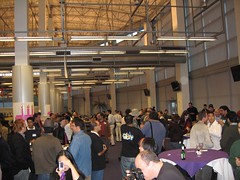The bookmarking service Del.icio.us has done quite a few “incremental changes” since I started using it. As has photo service Flickr. Here are two very small, but context-adding betterments that I like a lot.
Flickr’s small context-enhancers: more functional tags. Now Flickr sports a few tags that behave in a special way, apart from being one-word keywords. The tags geo:lat=100.10 and geo:long=123.123 situates a photo in a geographical context (visualized by inserting a GoogleMap on the page). Some cameras and photo-generating devices (urrg, bad word) insert that information right into their EXIF data (which is information embedded in the photo file), so the user doesn’t have to do a thing to get that geo-context.
Also, events published at the Upcoming.org service can be denoted with the Flickr special tag form upcoming:event=123123. 123123 is the ID of this fictional event. A text link with an Upcoming icon pointing to the event is shown with the photo. (The image linked to this article has that property.)
Del.icio.us’ incremental change can be dubbed context-sensitive representations. When you add a bookmark to an URL pointing to a usable media type (say, a photo, or an MP3), Del.icio.us adds either a thumbnail image, or a Flash-based audio player to the bookmarks listing. Makes your listings more immediately useful, without any extra brainpower on your part.

